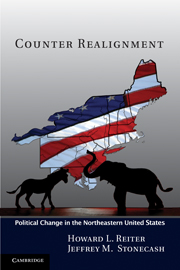Book contents
- Frontmatter
- Contents
- List of Figures
- List of Tables
- Preface
- Acknowledgments
- Postscript: Democratic Fortunes in the Northeast in 2010
- 1 Party Strategies and Transition in the Northeast
- 2 Party Pursuits and the Sources of Change
- 3 The First Republican Losses
- 4 Searching for a Majority, the Rise of Conservatives, and Second Losses
- 5 Interpreting the Goldwater Election and Pursuing the South
- 6 Social Change, Party Response, and Further Republican Losses
- 7 National Parties and the Position of the Northeast
- 8 The Process of Change and the Future
- Index
- References
1 - Party Strategies and Transition in the Northeast
Published online by Cambridge University Press: 05 June 2012
- Frontmatter
- Contents
- List of Figures
- List of Tables
- Preface
- Acknowledgments
- Postscript: Democratic Fortunes in the Northeast in 2010
- 1 Party Strategies and Transition in the Northeast
- 2 Party Pursuits and the Sources of Change
- 3 The First Republican Losses
- 4 Searching for a Majority, the Rise of Conservatives, and Second Losses
- 5 Interpreting the Goldwater Election and Pursuing the South
- 6 Social Change, Party Response, and Further Republican Losses
- 7 National Parties and the Position of the Northeast
- 8 The Process of Change and the Future
- Index
- References
Summary
Political parties are preoccupied with having majority status. When they are in the majority, they are often nervous about retaining power and continually search for new supporters. When they are in the minority, they seek to expand their electoral base. In both cases, a party seeks a strategy that will pull voters away from the other party. The strategy may be short term, as when candidates in a campaign try to use “wedge” issues to persuade voters attached to the other party to defect. In 1964, President Lyndon Johnson, wanting to improve his support among blacks in northern cities, supported civil rights measures. Other times, the strategy may involve a much longer-range plan. In the 1960s, Republicans sought gradually to move conservative Southerners away from the Democratic Party by expressing empathy with those angry about integration. Later the party sought to increase its support among those with strong religious commitments by expressing opposition to abortion and homosexuals. The effectiveness of these strategies in moving voters from one party to the other has been of considerable fascination and has received substantial attention.
These efforts, however, are not likely to be costless. Attracting one group of voters may alienate another. This possibility of losing voters, however, has often received less attention than strategies to gain voters. The plight of Democrats in the South has received the bulk of attention.
- Type
- Chapter
- Information
- Counter RealignmentPolitical Change in the Northeastern United States, pp. 1 - 14Publisher: Cambridge University PressPrint publication year: 2011



